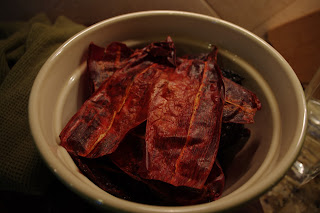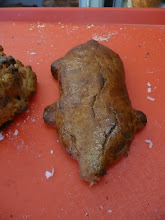I don't actually have a lawyer per se, but if I needed one I would choose the man I alluded to above. Not only was it his drunken, campfire brainstorming that came up with the name of this blog but he also likes to argue more than than anyone I know and as far as I can tell this is what makes a good lawyer. For example, I could say this to him: "You like to argue."
His answer would be: "No I don't."
And surely when he reads that he will think: "I wouldn't say that." His is a viscous circle of debate, and all who enter are instantly overwhelmed with argument.
Anyway, the other night my wife and I had this lawyer friend and his lawyer wife over for dinner. With their two little lawyers-to-be in tow, going out to eat was not in the cards so we settled for what was possibly the fourth-best option for eating after that (after ordering in, having someone else cook and microwaving pizza): me cooking.
 I decided to cook a big pot of red pozole which if all the stars align just right is something I can do relatively well. I originally stumbled across a recipe I liked in a Rick Bayless cookbook. What caught my attention was that Mr. Bayless had somehow pilfered the recipe from a small market stall in the pozole-rich bohemian neighboorhood of Coyaocan in Mexico City. My wife is from this part of the city and we visit this exact market just about every time we go to the Federal District. It is, without a doubt the best pozole I have ever eaten. I played with the Bayless recipe for a year or so but never felt it replicated the version we know and love from Coyoacan. Maybe because I never bought and boiled a pig's head, but I think somewhere in Mr. Bayless' recipe gathering, some items or steps were lost or more likely intentionally omitted. I mean, clearly Bayless is a culturally sensitive guy and I really do appreciate his respect of the Mexican culture, but we all know he isn't sending royalty checks out to these market-stall chefs he "borrows" recipes from, so I can't blame the pozole-master of Coyoacan for holding back a little.
I decided to cook a big pot of red pozole which if all the stars align just right is something I can do relatively well. I originally stumbled across a recipe I liked in a Rick Bayless cookbook. What caught my attention was that Mr. Bayless had somehow pilfered the recipe from a small market stall in the pozole-rich bohemian neighboorhood of Coyaocan in Mexico City. My wife is from this part of the city and we visit this exact market just about every time we go to the Federal District. It is, without a doubt the best pozole I have ever eaten. I played with the Bayless recipe for a year or so but never felt it replicated the version we know and love from Coyoacan. Maybe because I never bought and boiled a pig's head, but I think somewhere in Mr. Bayless' recipe gathering, some items or steps were lost or more likely intentionally omitted. I mean, clearly Bayless is a culturally sensitive guy and I really do appreciate his respect of the Mexican culture, but we all know he isn't sending royalty checks out to these market-stall chefs he "borrows" recipes from, so I can't blame the pozole-master of Coyoacan for holding back a little.To supplement my Bayless recipe, over the years I have watched my mother-in-law make pozole and from that come up with more or less my own version that I like to think comes out pretty damn well.
I start with a big can of hominy. Actually going back, I start all my pozole dishes with a trip to Liborio or other similar Mexican grocery. There you will want to get the big can of hominy. Also at Liborio you can get a big menudo/ tamale-steamer pot for a great price that is a perfect size for a healthy portion of this soup.
I drain and rinse the hominy well and add it to the pot. On top of it I add probably about two gallons of water. I start the flame and bring it to a rolling boil, lower to a simmer and add in five or six medium-sized cloves of garlic. After that I throw in the pork.
The pork for the pozole is likely the most important part. While it is true that a pig's head yields the tastiest dish, I've found that it is acceptable to get about a kilo each (it's fun to order in the metric system while in a Mexican market) of pork ribs, pork stew meat and something else bony or fatty like more ribs, neck bones or even the hodgepodge of meat at Loborio labeled "para pozole". Put all that in now with the garlic and let that simmer for at least a couple hours or until the hominy is soft. Stir often.
Once that is going break out 8-10 chiles anchos and 8-10 chiles guajillos. Open them, de-vein them and remove the stem and all the seeds. Heat a cast iron skillet and toast each side of each chile briefly until they blister but be careful not to burn them. If you do burn one, toss it and try again. This is really important.
Once all the chiles are toasted put them in a bowl and cover them with boiling water. Cover that bowl and let it sit for 20-30 minutes. Don't forget to stir your hominy, it likes to stick to the bottom of the pot.
Drain most of the water out of the chiles but save it. Blend the rest until it reaches the consistency of a runny paste. Add the chile water as needed. Strain the mixture through a medium-sized colander into the pot. At this time peal an onion, cut it in half and add it to the pot.
Take the pork out thirty minutes or so after the hominy is soft. Let it cool and shred it into a bowl. Now is the time to start adding salt. Taste every time you salt, but know that it is hard to over-salt anything with hominy. I usually start by adding 3-4 tablespoons and go from there. Remove the onion halves and adjust the flavor as needed by adding salt, boiling off some more liquid or adding some of the water the chiles soaked in.
When you get pozole in a market stall in Mexico the pork is added into each bowl. Likely this is so everyone gets his or her share of the good stuff, and one can also chose which parts of the pig he or she likes best. I just toss all the pork back in after I shred it and let it boil some more.
Traditional toppings for this red pozole include sliced radishes, chopped iceberg lettuce, diced onion, oregano and chile powder. It is also good to have some tostadas handy. Enjoy. Pozole, like many slow-cooked dishes is best the next day or when it has cooled some and is re-heated.
Well, if you are so inclined to try this recipe I hope you like it. Chance are there will be more of these recipe posts in my future as my life has suddenly and wonderfully changed a week ago with the arrival of healthy and beautiful twin boys. And so it might take me a few weeks to get back on board with a restaurant review (and leave the house again).

























































